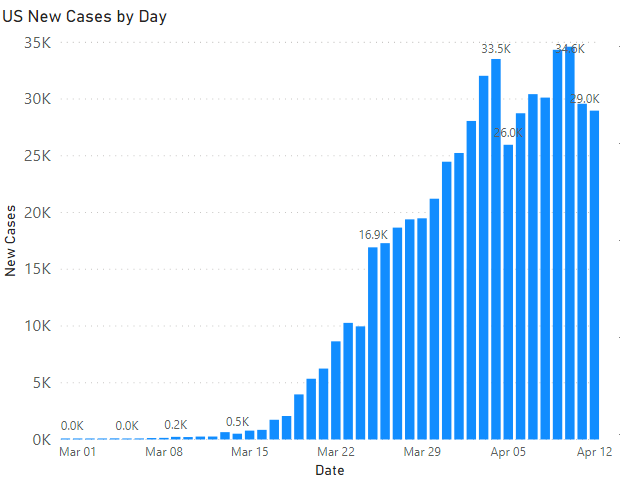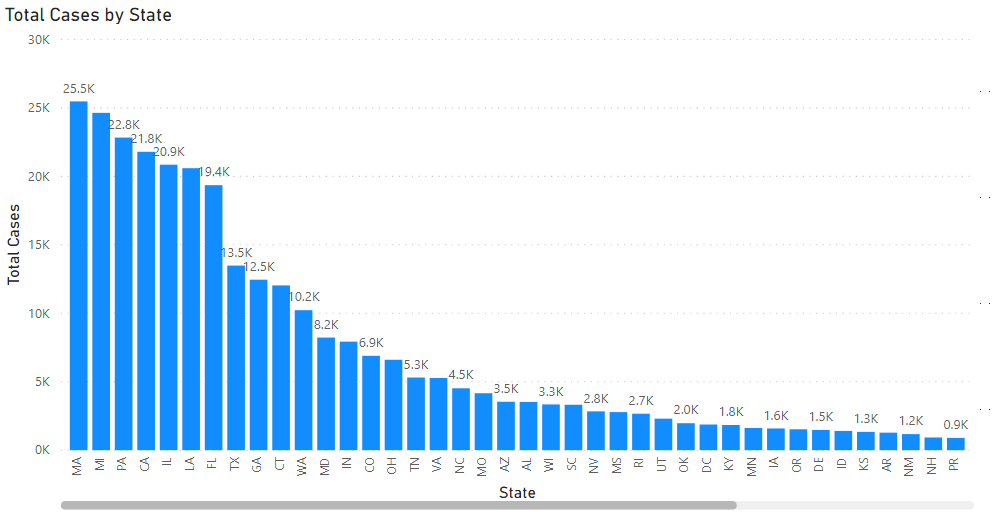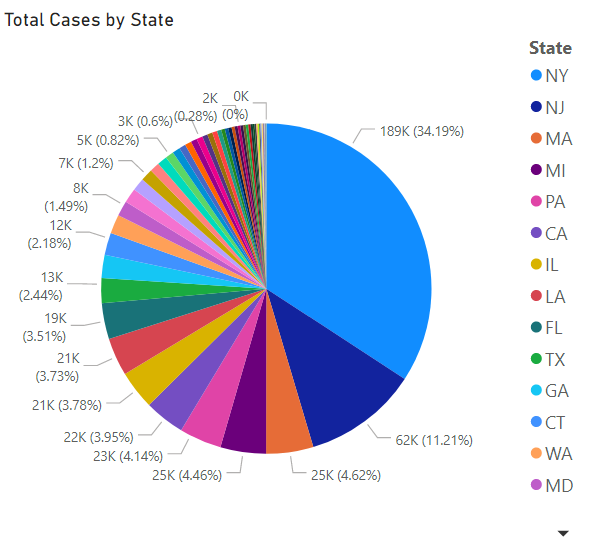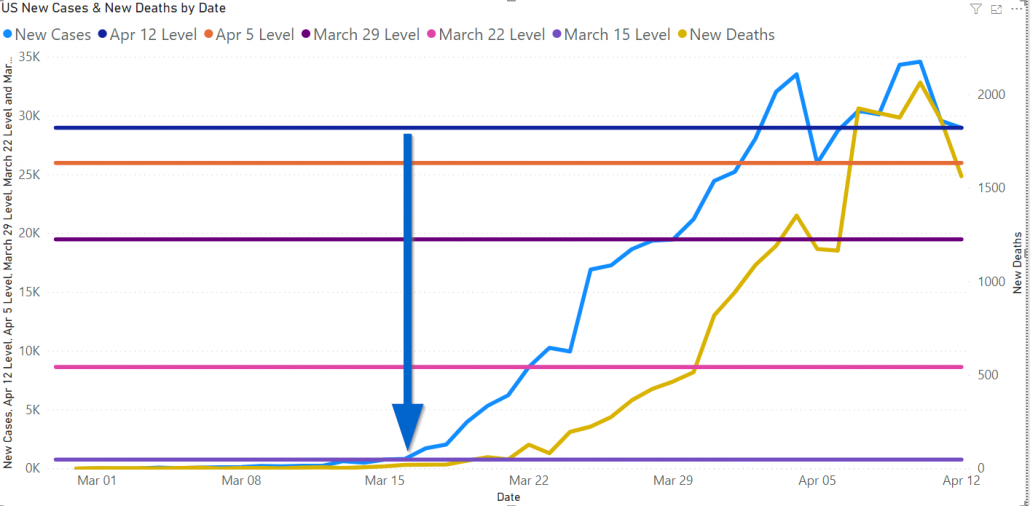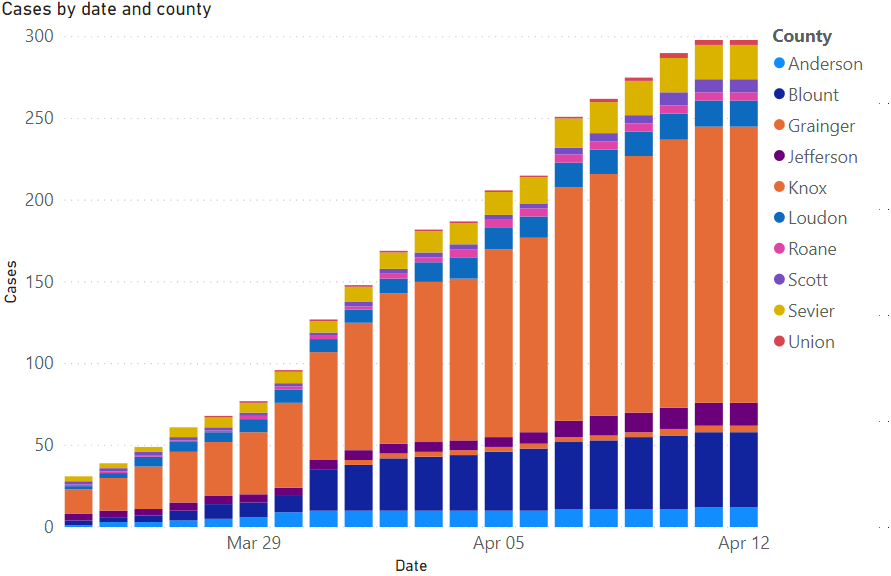Today is mostly a summary type of day. We have may have a second update later in the day if significant news comes out, especially from the TN daily briefing.
All in all, new cases are going down but lots of small problems are popping up. Welcome to the beginning of the new normal.
As a whole, new cases and deaths in the US are both down with about 29,000 new cases yesterday. For comparison, on March 22nd we had about 32,000 cases in the US in total. So, the good news is that adding as many cases as we had in a single day three weeks ago is better than where we were last week.
New York continues to completely dominate US cases.
If you take out NY & NJ you get a much more even distribution of cases across the US:
We think that there are two ways that you can read this data. First, the outbreak in New York makes the situation there different than in the rest of the county as a whole. Second, it’s still clear that there are other majors areas at risk for outbreaks.
If you break down those totals MA new cases are going up, MI is stable, PA is down three days in a row in cases but not deaths, IL is trending up, LA and FL are trending down. The point is that there isn’t an even response to COVID-19 across the US. We’d also like to note that one of the world’s leading epidemiologists recently stated that he doesn’t even trust the data unless there are at least ten days of trend behind it.
To give you another way to visualize it, here are new cases and new deaths by day across the US, with horizontal lines representing the levels at specific days. The purple one that lies just over the X-axis is 780 new cases/day, where we last were at on March 15th, which was one to two weeks before shelter-in-place orders became commons across the US. We’ve got a long way to drop.
East Tennessee & Knox County Numbers
New cases in Knox County are leveling off. To put that in context, they are around where we were at when the Knox County Safer at Home order went into place. We assume that the county wants to see cases below that point before re-opening.
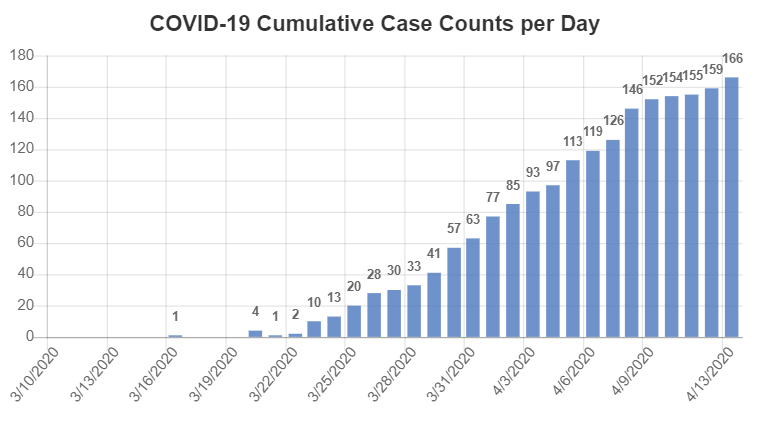
KHCD also released a zip-code based map of cases, based on symptoms that were present as of April 4th. That’s 37919 highlighted. Dr. Buchanan of the Knox County Health Department said that it wasn’t clear if the differences in zip codes were due to differences in cases or availability of testing. Zipcodes with fewer than five cases are not identified due to privacy concerns.
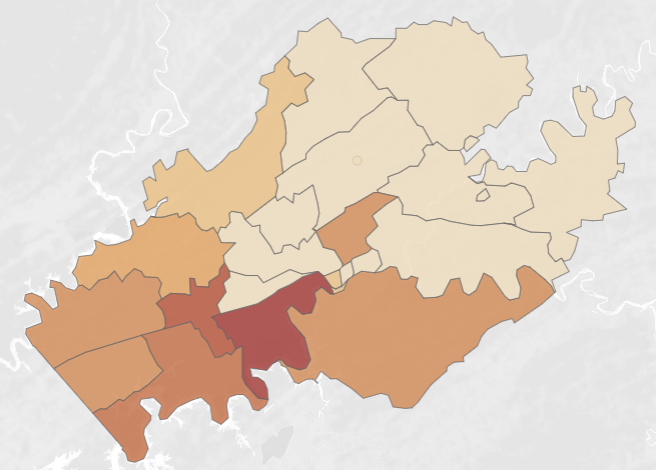
The New York Times data, which doesn’t track with local data exactly (the state data also doesn’t always track with local data) show the nine-county region somewhere between stabilizing and living off in new cases.
As always, take a few days worth of data with a grain of salt. (See Dr. Buchanan’s remarks on this specifically below.)
Notable Tennessee News
At today’s KCHD briefing Dr. Buchanan stated that she and Mayor Jacobs were not ready to limit the restrictions on travel and social distancing if Governor Lee allows his executive orders to expire (tomorrow at 11:59 PM). To consider lifting these restrictions KHCD would want to see a trend, more than a couple days of data.
“Where are we on the curve? That’s easy, we’re at the beginning. We’re still on the upslope of the curve… We need to see that for several days. One day of fewer cases does not mean that we flatten the curve, at all.”
Dr. Buchanan, April 13th, 2020 KHCD daily briefing
To get a test locally, the county has expanded qualifying symptoms to include loss of smell, loss of taste and “some GI symptoms,” beyond the more typical flu-like symptoms. KHCD is also prioritizing people at highest risk for complications, such as those with chronic medical conditions or healthcare workers that can’t otherwise be tested. Results from KHCD are currently being turned around in 3-4 days.
Mayor Indya Kincannon signed an extension of the City of Knoxville’s Safer at Home Order.
An employee at Target North in Knoxville was found to be positive with COVID-19. Given that, (1) most people are contentious before they are symptomatic (a 5-7 day lag), and (2) you can’t get tested without being symptomatic in most cases it seems likely that we’ll see some more cases come out of this.
19 staff cases of COVID-19 were found at two Tennessee correctional facilities. On Thursday during the TN daily briefing, it was announced that there would be mass testing at these two facilities, of staff only. The decision to test staff only is puzzling to us, given the lag in symptoms and confirmed cases we just mentioned we don’t understand how the offender population wouldn’t have cases as well. The state is issuing cloth masks, which haven’t been shown to be effective.
A Tyson plant just north of Nashville is being investigated for a possible outbreak of cases, no updates have been posted on this since Friday.
US Testing
US testing remains on a pretty much a straight line, i.e., we are not ramping up testing. The chemicals needed to run the tests are in short supply. That means we can’t expect to see the number of new tests per day increase until we figure out how to increase the supply chain.
Also, as Dr. Osterholm notes, many of the “re-opening” plans rely on widespread testing. There isn’t any evidence that we can actually accomplish wide-spread testing, right now.
The turn around time of the tests is also a major concern. As Bill Gates noted on CNBC’s Squawk Box, the test results are most valuable within the first 24 hours of the test. The longer you take to test the more you’ve allowed the virus to spread.
Any time the queue [test result time] is over 24 hours that’s complete mismangement because the value of the result is far less worthwhile… the best case is [the test] goes positive before you’re symptomatic or infections; and then you can act in such a way that don’t infect anyone else.
Bill Gates, Squawk Box, April 9th, 2020
The Food Supply Chain
A fantastic article on Medium explained how the toilet paper shortage is more about supply chains than hoarding. In short, “the average household will use 40% more toilet paper than usual [at home],” under social distancing. The single-ply toilet paper you have at your office, hotel, conference center, etc., literally comes from different factories and they can’t just flip a switch to make the double-ply stuff you buy at Kroger instead. We believe that this insight explains a lot of empty shelves at grocery stores, beyond TP.
Indeed, there are multiple reports about the disruptions coming in the food supply chain. First, the supply chain needs to change. Restaurants and hotels don’t need nearly as much food as they did before, grocery stores and food shelves need lots more. But it’s more complicated than just changing where trucks deliver their goods, the type of food changes as well. Second, slowing immigration (due to COVID-19) will make it difficult to let in the immigrants who come to harvest our crops.
Third, the factories that produce our food — especially meat — have to cope with COVID-19 as well, and they simply aren’t set-up for social distancing. 5% of pork production in the US was cut today with the idling of a single plant. Fourth, there are inter-dependencies that are not well-understood outside the food industry. One expert told us about how cutting sports was going to affect animal feed:
So, there’s an ingredient called wheat middlings. It is essentially the leftover stuff after you make white flour. White flour is used mainly in hotdog and hamburger buns, which aren’t being eaten at the same rate because sporting events are closed. Same with restaurants. First thing you get on the table is bread. We aren’t eating as much as a nation. These wheat middling are used in most animal feed as an energy source as well as a pellet binder (The feed usually comes in pellet form.)
No baseball, no buns, no flour mills making white flour, no middlings.
We’ve personally seen this, where local grocery stores are out of essentials (flour, meat, toilet paper, etc.) it is still available to us from the commercial supply chain.
What Does it Mean to Re-Open?
We released our own whitepaper on what we believe next few weeks will look like, to be clear, there will only be a new normal for months not a return to old normal. Vox.com reviewed four of the re-opening plans and summarized them all:
…there is no normal for the foreseeable future. Until there’s a vaccine, the United States either needs economically ruinous levels of social distancing, a digital surveillance state of shocking size and scope, or a mass testing apparatus of even more shocking size and intrusiveness. […] All of them then imagine a phase two, which relaxes — but does not end — social distancing while implementing testing and surveillance on a mass scale. This is where you must begin imagining the almost unimaginable.
Ezra Klein, Vox.com
Axios has their own summary which reads a lot like our own, “The future will come in waves — waves of recovery, waves of more bad news, and waves of returning to some semblance of normal life.”
You need to be seriously considering how your business, non-profit, family will operating inside this new normal. We’ll get through this, but getting through it successfully will require planning and effort.
Financial
IRS Stimulus Check Registration Tool: read about it on Forbes, you probably don’t need to use it.
BlueCross of Tennessee sent us an email stating that they are waiving all member costs for COVID-19 treatment:
As part of our mission to serve your employees, we’re removing their barriers to receiving care. From now until May 31, 2020, we’ll waive member cost sharing for COVID-19 treatments, including hospitalizations.
BlueCross of Tennessee
If your employee or one of their dependents is diagnosed with COVID-19, they won’t pay out-of-pocket costs for treatment from in-network providers, including inpatient treatment.
International
Spain is lifting its strictest two-week lockdown. “That means that the majority of the population of Spain remain in their homes – schools, bars, restaurants, cultural venues and leisure centers all remain closed – but the economic activity that was halted with the hibernation decree will restart.”
Singapore, a country that has done very well to date, is under a partial lockdown as its cases jump.
The South China Morning Post reports that “China is taking extra measures to stem the influx of imported cases of coronavirus, particularly from Russia after a small border city reported a dramatic jump in new cases among arrivals.”
Cloth Masks: A Brief Side Note
Earlier we alluded to a paper in the National Academy of Sciences, Engineering, and Medicine that said, “The current level of benefit [of wearing cloth masks], if any, is not possible to assess.” In large part, because there are very few studies done on the effectiveness of cloth masks, especially homemade ones. We will, for now, continue to use them out in public. However, there are two important caveats, (1) any benefit from cloth masks are to the public, not the wearer (it doesn’t protect the wearer), (2) it’s not a public policy response.
How JM Addington is Adjusting
Our thoughts and plans are shifted towards June and July. We believe that our financials are sound enough that we can bear front wave of the storm. The next part, learning to operate in our new normal will take more careful planning:
- How do we keep our team safe?
- How do we keep our customers safe?
- What new services from us are our customers going to need?
- Which if our customers are going to be negatively affected in 90 days? Which will see an uptake in business?
- How is the competitive landscape going to change? Will price matter more in an economic downturn, or provider capacity to respond quickly and turn on a dime?
These are some of the questions we’re grappling with right now.
Get In Touch
Need help thinking this through? Access to more data? Help getting your technology in order to handle what’s here and what’s coming? Contact us today.
Other
Thanks to those that have shared kind words or liked these posts. We’re doing out best to put out data-driven analysis, each one of these takes about 2 hours. It’s helpful to know that they are being read.
If you want copies of the Excel sheet and PowerBI Reports we use to put these together email us, info@jmaddington.com. Right now, our PowerBI combines data from JHU, NYT, COVID Tracking Project, IMHE and the TN Department of Health. Most sets are updated daily.
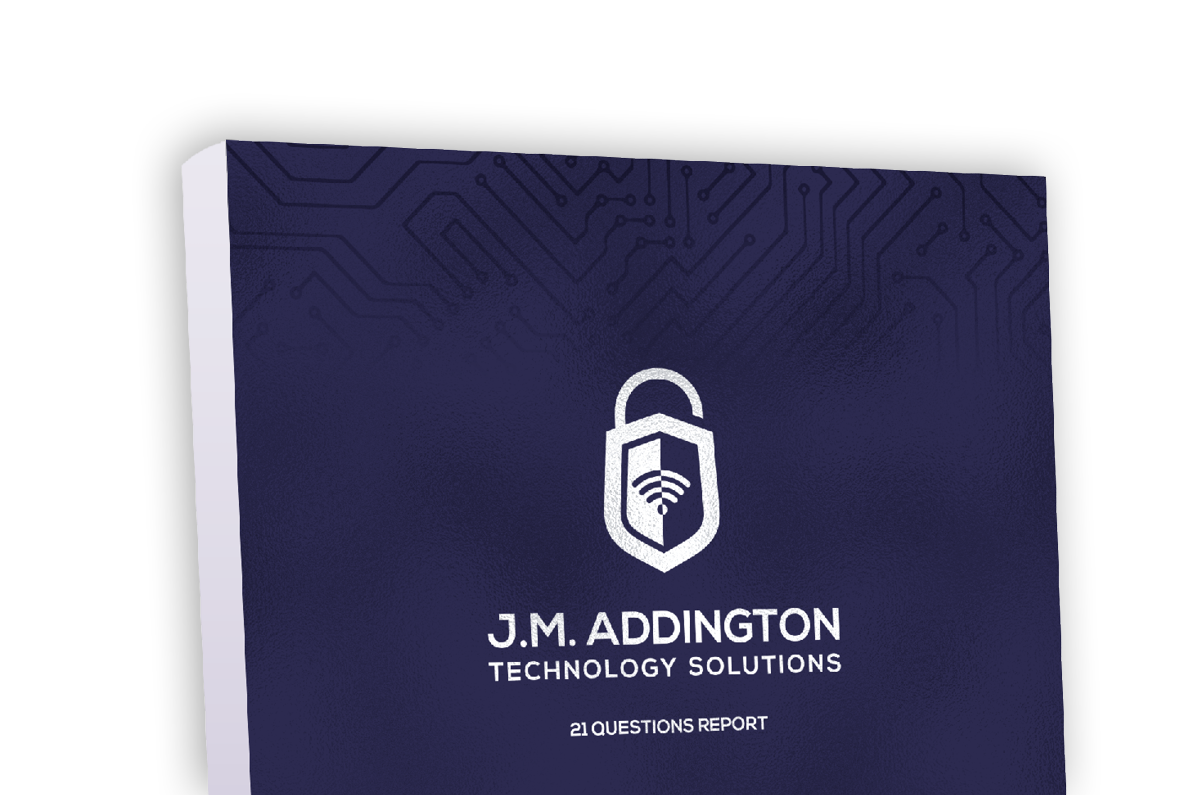
Download our Report!
Get your copy of What Every Business Owner Must Know About Hiring an Honest, Competent, Responsive, and Fairly-Priced Computer Consultant.

